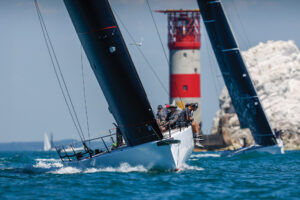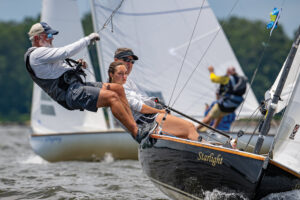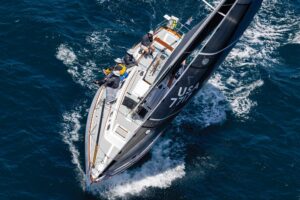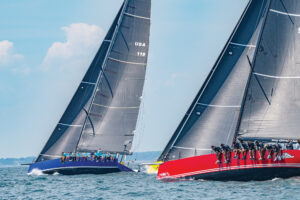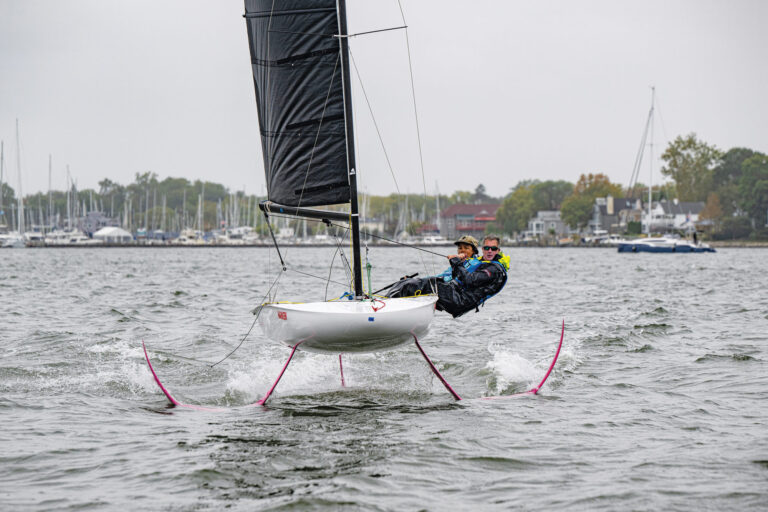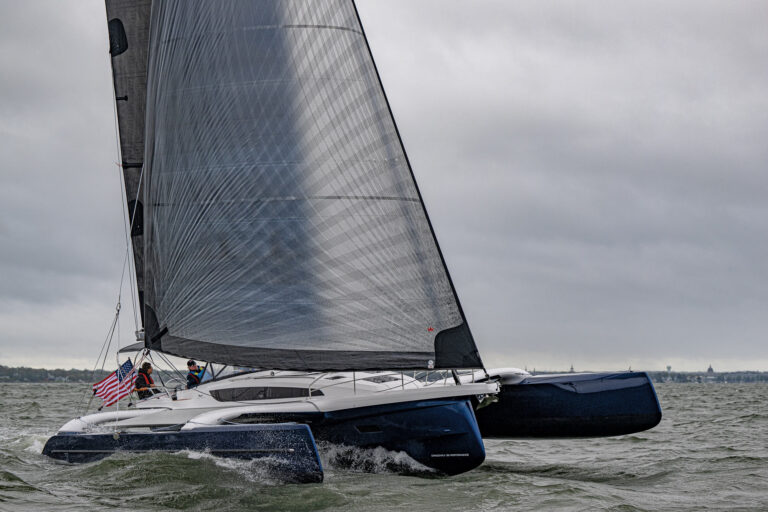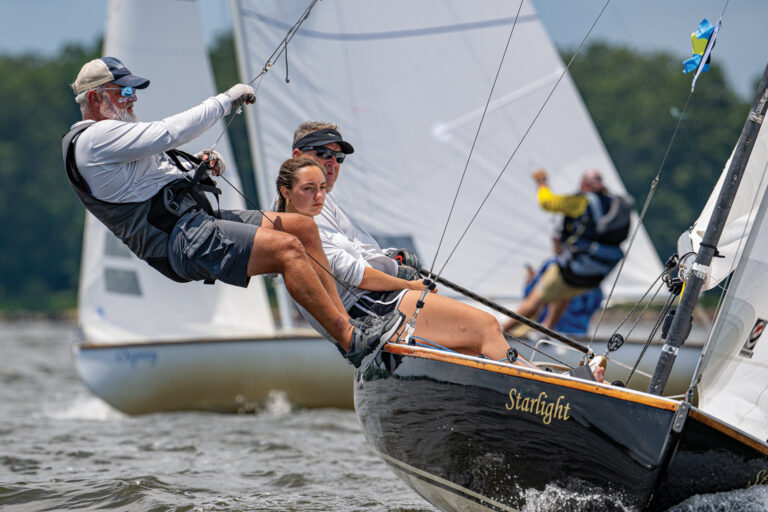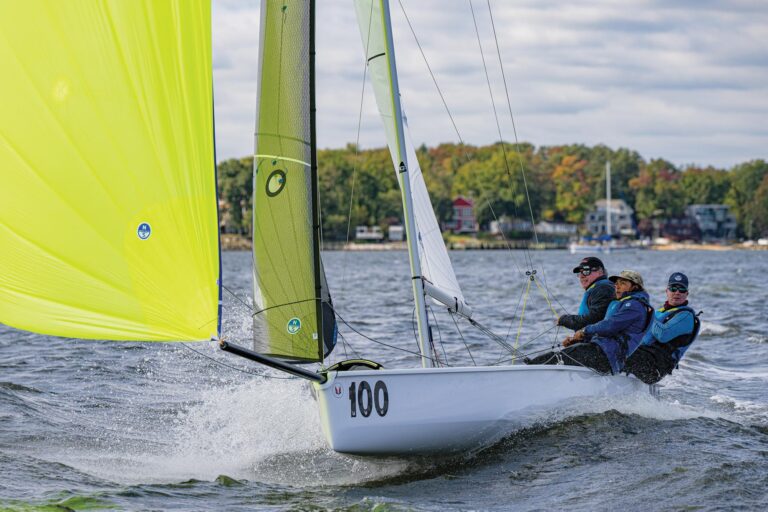
Andy Green
**Andy Green (former match racer and well-known America’s Cup commentator) and Tucker Thompson (owner of www.t2p.tv/ video production and broadcasting) have the onerous task of commentating on the first “races” of the Louis Vuitton Cup. **It is a task unique in that, with the exception of one “real” race–which didn’t count anyway as the trailing team did not complete the race within the time limit–the remaining “races” have seen Emirates Team New Zealand and Luna Rossa solo it around the course. Bizarre but real, and looking at the AC schedule through the end of July, there’s plenty more one-boat racing to come. So just how do professional commentators take this “racing” seriously, and make it interesting for those wondering, “What the heck?” Here, the ever-gregarious Green (38) tells how it’s done.
What’s it like commentating on a one-boat “race”?
AG: First off, in both Auckland and Valencia, in the first month of the Louis Vuitton Cup there was similar public concern over the success of the event. In Valencia we had super light wind and a lot of the racing had to be canceled–it was like the next disaster of the America’s Cup; in Auckland not nearly as many people showed up in the early stages as they thought there would be, particularly during the weekdays. From that point of view, I see what San Francisco has done to encourage a reasonably healthy number of people to come visit the site.
As far as the one-boat races are concerned, Tucker and I have taken the view that we’re served with a plate, and we have to make the best meal of it that we can. What we’ve tried to do is bring in lots of guests, other experts, we’ve been able to get very comfortable with some of the rules and things that we will see on the racecourse. It’s an opportunity for us to educate the super keen fans who are watching about the racing. There are a remarkable number of people who will take anything from the America’s Cup. They’ll watch anything, including one-boat racing because they want to see the boats foiling, and they want to see the crew work. A lot of people have been very passionate one way or another about this new boat and the America’s Cup, so we’ve had loads of messages on Twitter and Facebook. The last couple of one-boat races we had Dave Carr (Luna Rossa) and Richard Meacham (ETNZ), both of whom have been our best guests, who provided some fascinating insight into what’s happening on the boat. The races are shorter, so when we get closer to “sporting” races with two boats and hoping that the races will be close enough, there won’t be any time to talk about the more intricate elements of putting the board up, the wing faring, the aero and hydro design packages.
What are you learning in this new AC?
AG: The fundamentals of sailing a boat are still the same. However, what is very clear about these boats is the coordination of crew work is critical, so things are happening so fast. They’re “under-staffed,” but there are lots of things that have to happen in a jibe or a tack: the boards up and down, the wing across, everyone traveling across the boat, grinding. It’s an extremely choreographed performance that requires all 11 people.
The other thing that’s clear is how much there’s left to do to refine the boats. The boats are traveling downwind sometimes up to 40-plus knots so the farings and aero packages that are on the beams are increasingly important. The aero refinement could mean another knot-plus for your boat. Certainly one of the teams are looking for another knot in aero refinement. That’s quite a lot.
Yesterday Luna Rossa came out with different aero boards on their front beam. They were about 2-3 feet longer on the beam, and that’s a good example of aero foil refinement. That was obviously an improvement.
The third thing we’ve learned is the very interesting trade off between how early you get the boat up on the foils and how much drag you generate underneath the boat. The crew work, aero and hydro and the foil element, which is rudder and daggerboard–specifically the angle at which the daggerboard comes into the water and how curved or straight it is–has a significant implication on whether you foil early or late, and how much drag you generate under the boat.
**Now you’re tuned into these details, how much of it can you observe while you’re commentating?
AG: **We can see some of it, as we did yesterday with our guest helping point out some of the details. Tucker and I are learning as each day goes by. We’re doing tours of the bases. We’ve got another tour booked in with Luna Rossa and Oracle on Friday, so that’s another chance for us to look at some of the developments and get answers to the questions we’re being asked by the public.
Do you think we really will see close racing? Do you think Luna Rossa is going to pick up their pace?
AG: I hope so. I know they’ve got lots of developments they can make. At the end of the day, I’m a big fan of the America’s Cup, and I just want to see good, interesting racing.
**What are you seeing with the boathandling that you can comment on?
AG: **Certainly, ETNZ is like a slick operation. I haven’t seen anyone yet show off their moves so publicly both racing and in media. Oracle have got some great media but haven’t shown quite the same extent of what they have. I can entirely believe that’s strategic, holding stuff back. The Kiwis don’t really have that luxury because they’re already in the Louis Vuitton Cup. It’s very hard to go out, even on a one-boat racecourse day and not race at pretty much your hardest. They’re out there practicing jibes and showing off their moves, and they’ve got some funky moves.
**The big deal this past week is the rate at which, and the stability at which, ETNZ’s been able to get through a foiling jibe. Comments?
AG: **As I said, ETNZ have shown some pretty slick moves. A couple of foiling jibes on the second race when they were just doing the one-boat race–no less than 30 knots through a foiling jibe, never coming off the foils. There’s a general feeling around the Challenger camp that’s pretty impressive. We had Murray Jones as our guest that day. He wasn’t shouting from the rooftops that Oracle had been able to do that for months already, he was more circumspect. If all the boats with the exception of Artemis are foiling jibing come the LV finals and the AC match, we’ll get some pretty cool racing.
Generally, what do you think of the boats?
AG: I think they’re amazing; I think they’re mesmerizing. They’re beautiful, which is one of the crucial elements of having an America’s Cup design. America’s Cup has been very lucky to have developed beautiful boats. The TV coverage makes them look even better. We’re still in the early stages, so there’s not as many cameras about as there will be, but all the bells and whistles on board will come. The TV is fantastic with the boats.
One big concern for me is that they’ve got rid of the spinnakers. You don’t get quite the same sense of upwind and downwind. You know the boats are going downwind because they’re foiling, but it’s a shame for the non-sailor not to see someone pulling a line and the spinnaker going up and rolling out. I really enjoyed that with the AC45s. My suggestion for the next go around would be to find a boat you can have a gennaker, but it’s hard to do that when the jibes are so fast on these boats downwind.
Do you think the starts will become exciting?
AG: You can’t win an America’s Cup race unless you know how to match race. With these boats, if you get ahead there are a loads of ways you can keep a boat behind you. You can’t win the America’s Cup if you get stuffed at the start in every match race. It’s hard to. The boats are amazing, and all previous America’s Cups have always delivered. The real America’s Cup fan will spend four years excited, upset, moaning, going through the roller coaster of emotions, and all they really want to see is the first two minutes of the first race of the America’s Cup. You have to be kind of crackers, but that’s the moment that’s so exciting.
Any other observations from where you sit?
AG: The facility here is amazing. I’m an independent commentator but part of me wants it to stay here. So much effort has been put into it that it’d be nice if it could stay in San Francisco and go around here, but that’s not the way of the America’s Cup.
Listen along as Andy Green and Tucker Thompson commentate on the Louis Vuitton Cup race between Luna Rossa and Emirates Team NZ on July 21_ [and don’t miss the disaster at 0:25:38!]_:
Click here to read more America’s Cup interviews from Michelle Slade.

